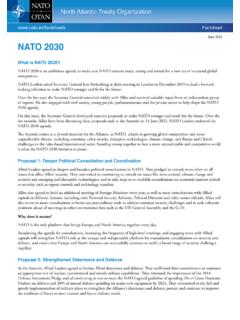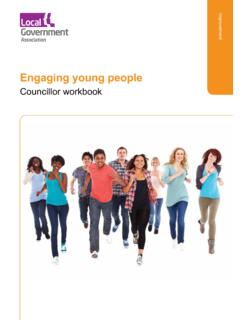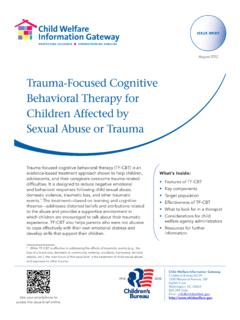Transcription of Community Resilience Development Framework - GOV.UK
1 1 Community Resilience Development Framework A reference tool for the delivery of strategic approaches to Community Resilience Development , at the Local Resilience Forum level in collaboration with non-statutory partners. June 2019 Crown copyright 2019 Produced by Cabinet Office You may re-use this information (excluding logos) free of charge in any format or medium, under the terms of the Open Government Licence. To view this licence, visit or email: 2 Community Resilience Development Framework This Framework is intended as a reference tool for the delivery of strategic approaches to Community Resilience Development at the Local Resilience Forum level in collaboration with non-statutory partners. The Community Resilience Development Framework provides an overview of: 1. the strategic and policy context; 2. the roles and responsibilities of government, statutory partners and Community networks; 3. the public s contribution to Resilience ; 4.
2 Understanding and engaging Community networks; 5. the steps for strategic approaches to developing Community Resilience , and 6. examples of guidance, tools and programmes. Section 1: The strategic and policy context for Community Resilience Development This section sets out the aims, objectives, benefits and outcomes for Community Resilience from a national and local perspective. It outlines the principles for how Community Resilience should be supported. The aims of Community Resilience : a participatory approach to emergency management Emergencies are defined as an event or situation which threatens serious damage to human welfare in a place in the UK, the environment of a place in the UK, or the security of the UK or of a place in the UK. 1 Individual and business Resilience to emergencies is about the public being aware of risks that might impact them, or the continuity of their business, and taking action to plan and prepare, respond and recover from these emergencies.
3 To support Community Resilience responders partner with the public by sharing knowledge, enabling independent and collective action, and utilising public knowledge and capabilities. When considering the public we are talking about individuals, businesses, Community networks and voluntary organisations. Community Resilience is enabled when the public are empowered to harness local resources and expertise to help themselves and their communities to: prepare, respond and recover from disruptive challenges, in a way that complements the activity of Category 1 and 2 emergency responders; plan and adapt to long term social and environmental changes to ensure their future prosperity and Resilience . Community Resilience requires a participatory approach to emergency management. This guidance focuses on Community Resilience Development as a process rather than an end state. Activity to support Community Resilience aims to reduce the impact of emergencies by ensuring that: Individuals, businesses, Community networks and voluntary organisations are empowered to prepare, respond to, and recover from emergencies and disasters.
4 Emergency responders understand, enable and integrate the capabilities of the public into emergency planning, response and recovery activity. 1 Cabinet Office, Civil Protection Lexicon, 19 February 2013 3 National Resilience and civil society context for Community Resilience The promotion of Community Resilience is part of the government s national security strategy. The National Security Strategy and Strategic Defence and Security review made the following statements and commitments in relation to Community Resilience : The UK s Resilience depends on all of us the emergency services, local and central government, businesses, communities and individual members of the public. We will expand and deepen the government s partnership with the private and voluntary sectors, and with communities and individuals, as it is on these relationships that the Resilience of the UK ultimately rests. We recognise that the response to, and recovery from, an emergency is carried out first and foremost at the local level.
5 As well as the police, fire and rescue and health services, a wide range of organisations could be involved. These include local government, voluntary service organisations, businesses, Community groups and individuals. The importance of a whole of society approach to Resilience was further emphasised in the National Security Capabilities Review 2018. Community Resilience is all about working with civil society to create social value and achieve a more resilient UK. This is vital for emergencies, but these principles are also relevant across the whole spectrum of public service delivery. The Civil Society Strategy: Building a future that works for everyone, 2018, outlines key principles around working with civil society to create social value. The principles outlined in the strategy are the same ones that underpin Community Resilience . The activity and approaches to build Community cohesion and tackle loneliness also build Community Resilience to emergencies.
6 Emergency Resilience activity should be aligned with more general Resilience building activity and vice versa. The Industrial Strategy identifies Places: prosperous communities across the UK as one of the five foundations of productivity. Local Industrial Strategies will be agreed, building on local strengths and led by Mayors and Local Enterprise Partnerships. Community and businesses Resilience Development should be aligned with this work to support prosperous communities. Local emergency responder activity Specific activities to achieve Community Resilience are agreed and managed locally through Local Resilience Forum (LRF) structures by emergency responders and their partners. LRFs should agree the strategy and approach to Community Resilience in their area, including how Community Resilience will be integrated with: statutory duties the Civil Contingencies Act 2004 ( the Act ) places on emergency responders, the LRFs generic emergency response and recovery plans, and existing Community engagement activity across issues beyond emergency management.
7 The following duties in the Act relate to the objectives of Community Resilience . Category 1 responders are under a duty under Section 2 of the Act to: Assess the risk of emergencies occurring and use this to inform contingency planning. Maintain business continuity plans. Maintain emergency plans, so the body is able to perform its functions in regards to preventing the emergency or mitigating its effects. Arrange for the publication of these plans, in so far as is necessary or desirable to prevent or mitigate the effects of the emergency. Maintain arrangements to warn the public, and to provide information and advice to the public, if an emergency is likely to occur or has occurred. Local authorities are under a duty under Section 4 of the Act to provide advice and assistance to the public in connection with the making of arrangements for the continuance of commercial activities by the public, or the continuance of the activities of bodies other than public or local authorities whose activities are not carried on for profit, in the event of an emergency.
8 (Part 1 Local Arrangements for Civil Protection, Contingency Planning, section 4. Advice and assistance to the public). 4 Any public engagement should be conducted with reference to The Public Sector Equality Duty: Equality Act 2010, which requires public bodies to have due regard to the need to eliminate discrimination, advance equality of opportunity and foster good relations between persons who share a relevant protected characteristic2 and those who do not when carrying out their activities. This includes specific duties for engagement by public authorities. The following diagram summarises the aims, objectives, actions, outcomes and benefits that local emergency responders strategies to support Community Resilience should consider. 2 The relevant protected characteristics are: age; disability; gender reassignment; pregnancy and maternity; race; religion or belief; sex; and sexual orientation.
9 1. Enabling resilient behavioursInforming and listening to the public about risk, appropriate preparedness and response actions, motivations and blockers to action. Response communications and alerting Education and awareness materials, programmes and campaigns2. Enabling Community led social actionSupporting Community networks to understand their capabilities, access resources, tools and responder partners and take collective Resilience action with benefits for people and places. Facilitating and advising Community networks Supporting Community led emergency planning Facilitating access to training and physical emergency resources3. Partnering with voluntary capabilitiesWorking with individuals, businesses, Community networks, Community Emergency Volunteer Teams, spontaneous volunteers and voluntary organisations to co-produce, design and deliver support to the public. Convening and consulting on plans Agreeing roles and activation models dependent on need and appropriate to capabilities Involving voluntary capabilities in exercisesA.
10 Individuals, businesses, Community networks and voluntary organisations are empowered to prepare, respond and recover from emergencies and Emergency responders & government understand, enable and integrate the voluntary capabilities of the public into emergency planning, response and recovery behave in a resilient and prosocial : understanding of needs and ability to target support those in acutest need public confidence and motivation to act collective capability to manage emergencies trust and legitimacy of official emergency management activity speed of recoveryCommunity networks take action to support their members to be capabilities are integrated into emergency : social, financial and health impacts from emergencies demand on emergency management resources cost of response and recoveryObjectivesBenefitsOutcomesAims 5 The benefits of a participatory approach to emergency management Individuals, businesses and communities benefit from: greater capacity, motivation and confidence to take positive collective action to prepare, respond and recover from emergencies quicker and more efficient response and recovery reduced exposure to social, financial and health impacts from emergencies stronger relationships with government and responders resulting in mutual trust and influence stronger sense of Community , with greater inclusivity and cohesion Government and emergency responders benefit from.















